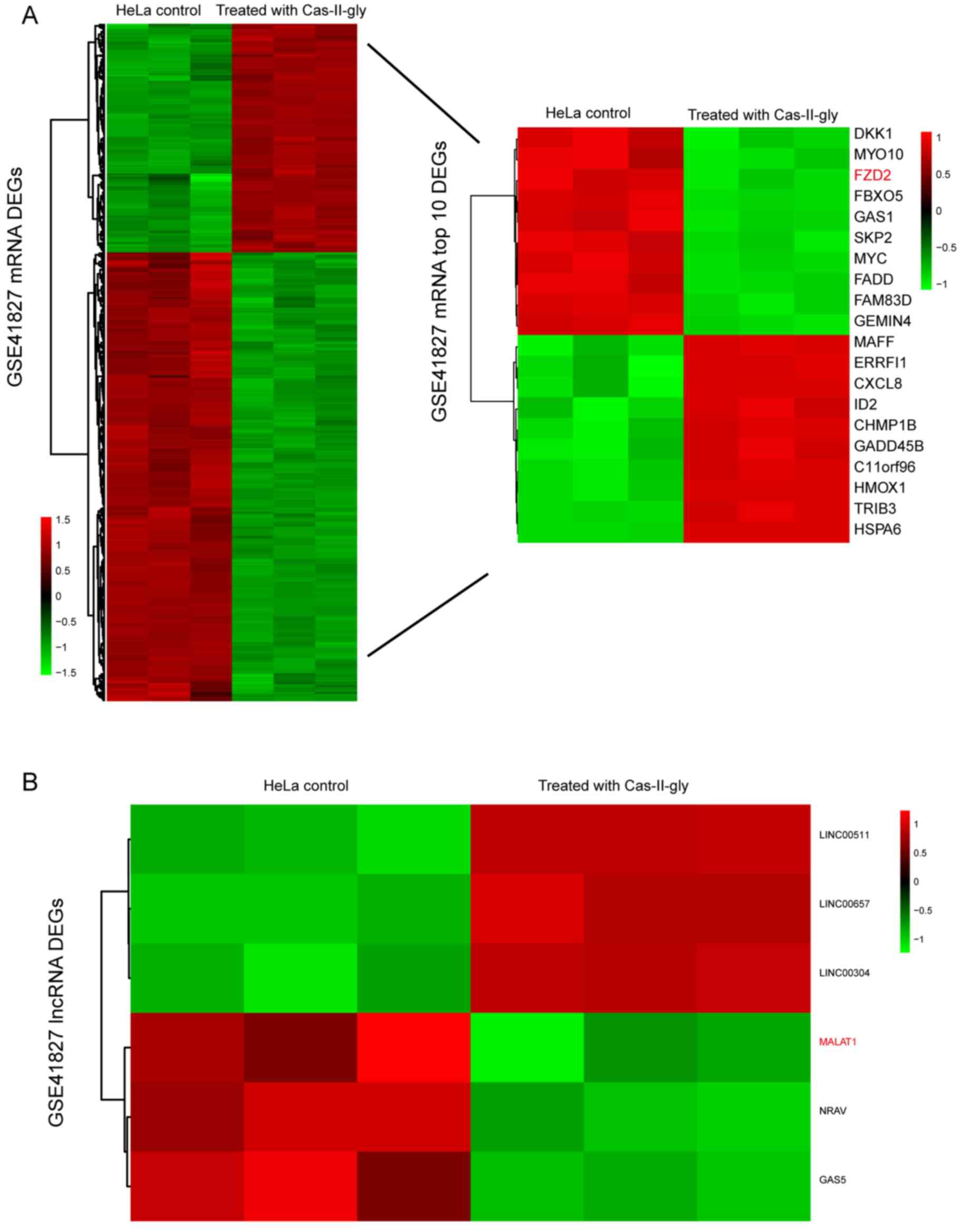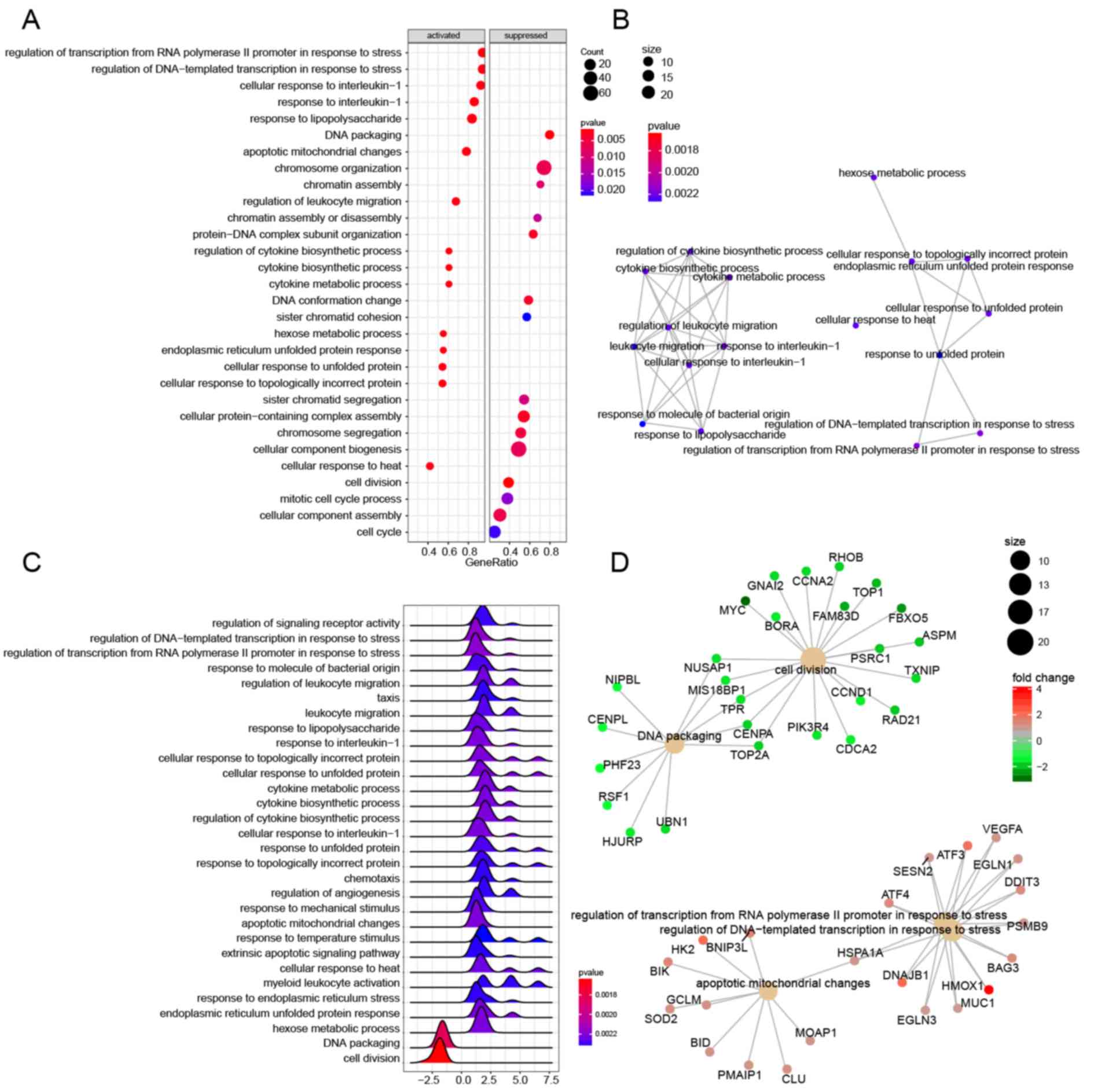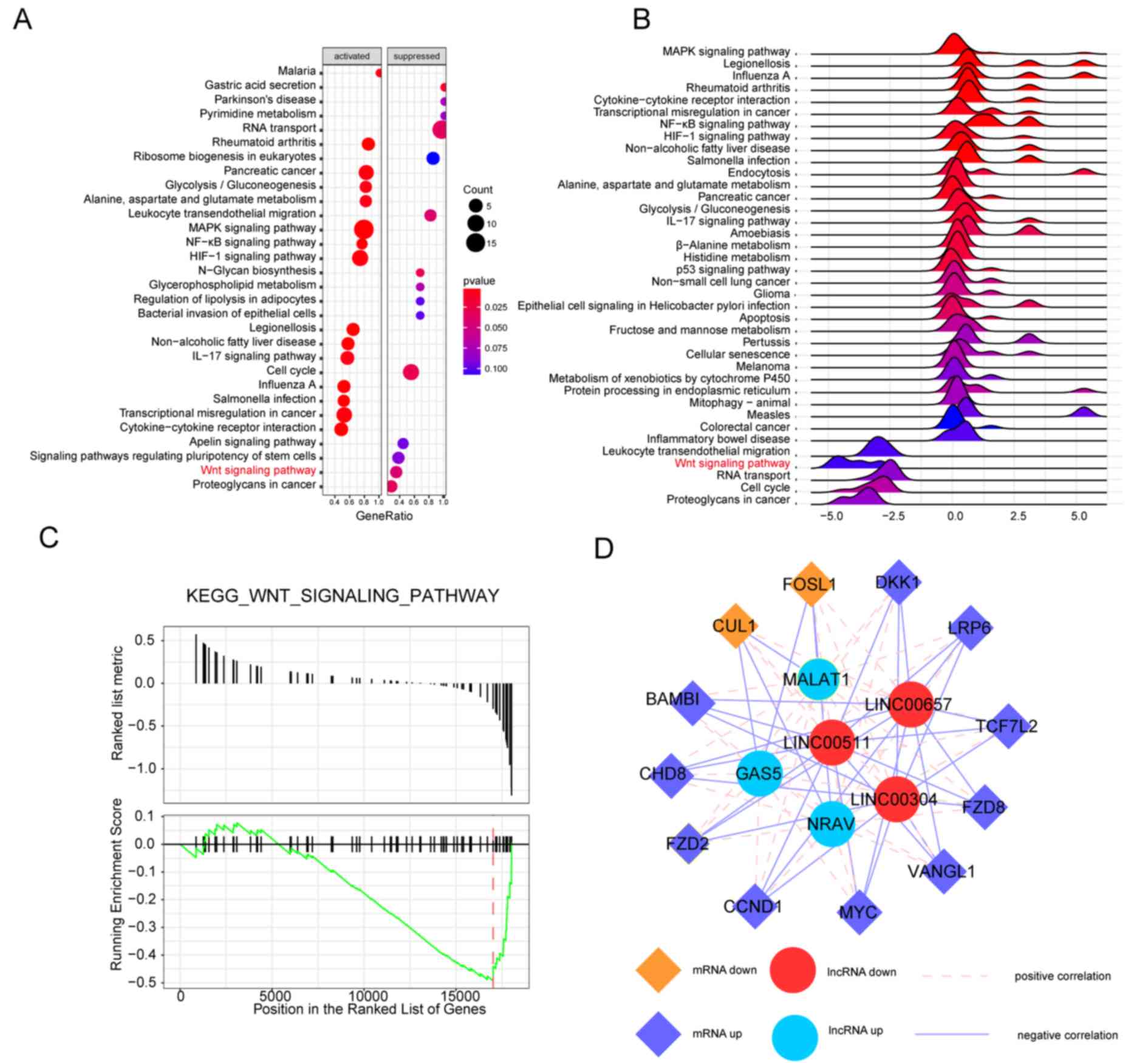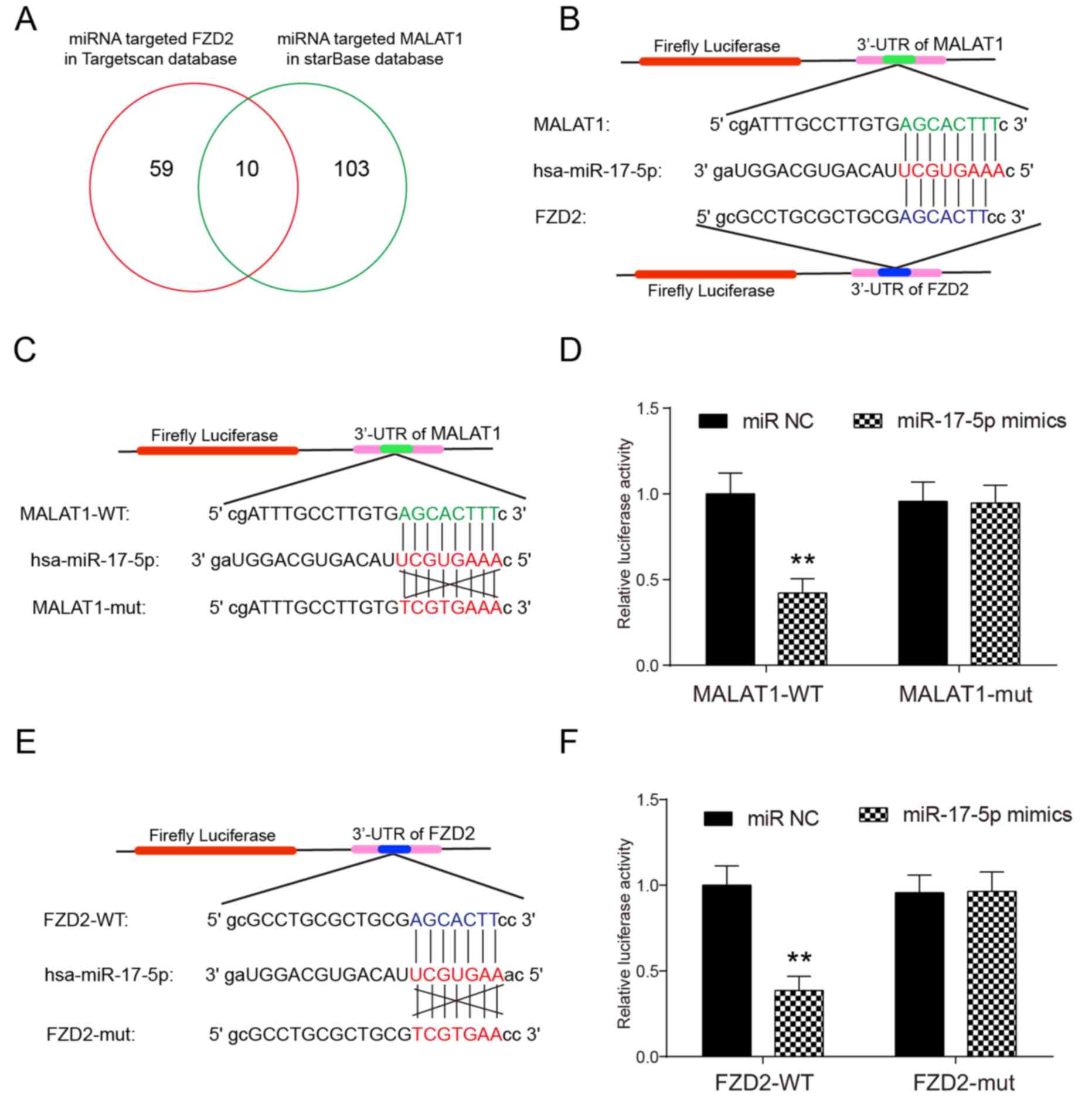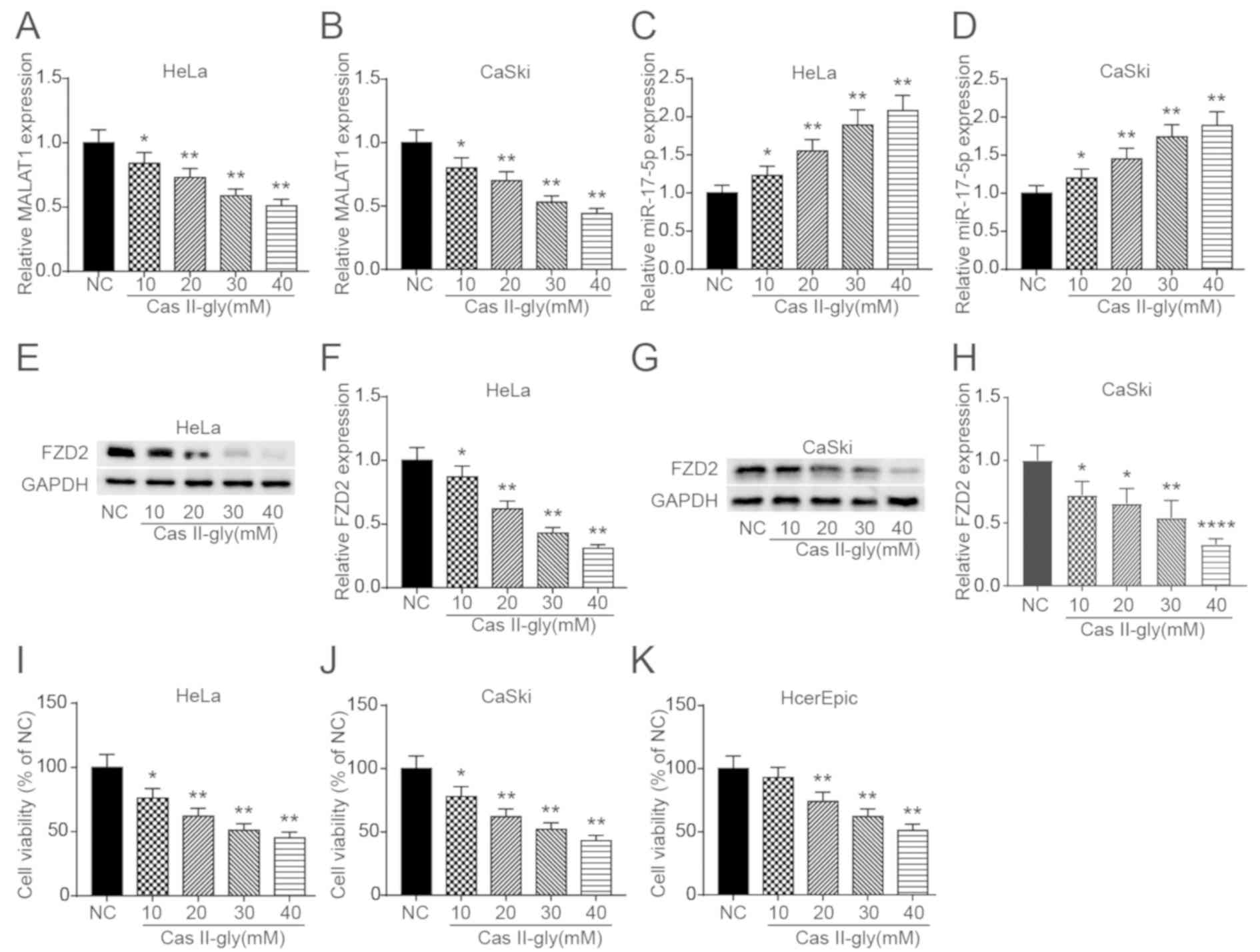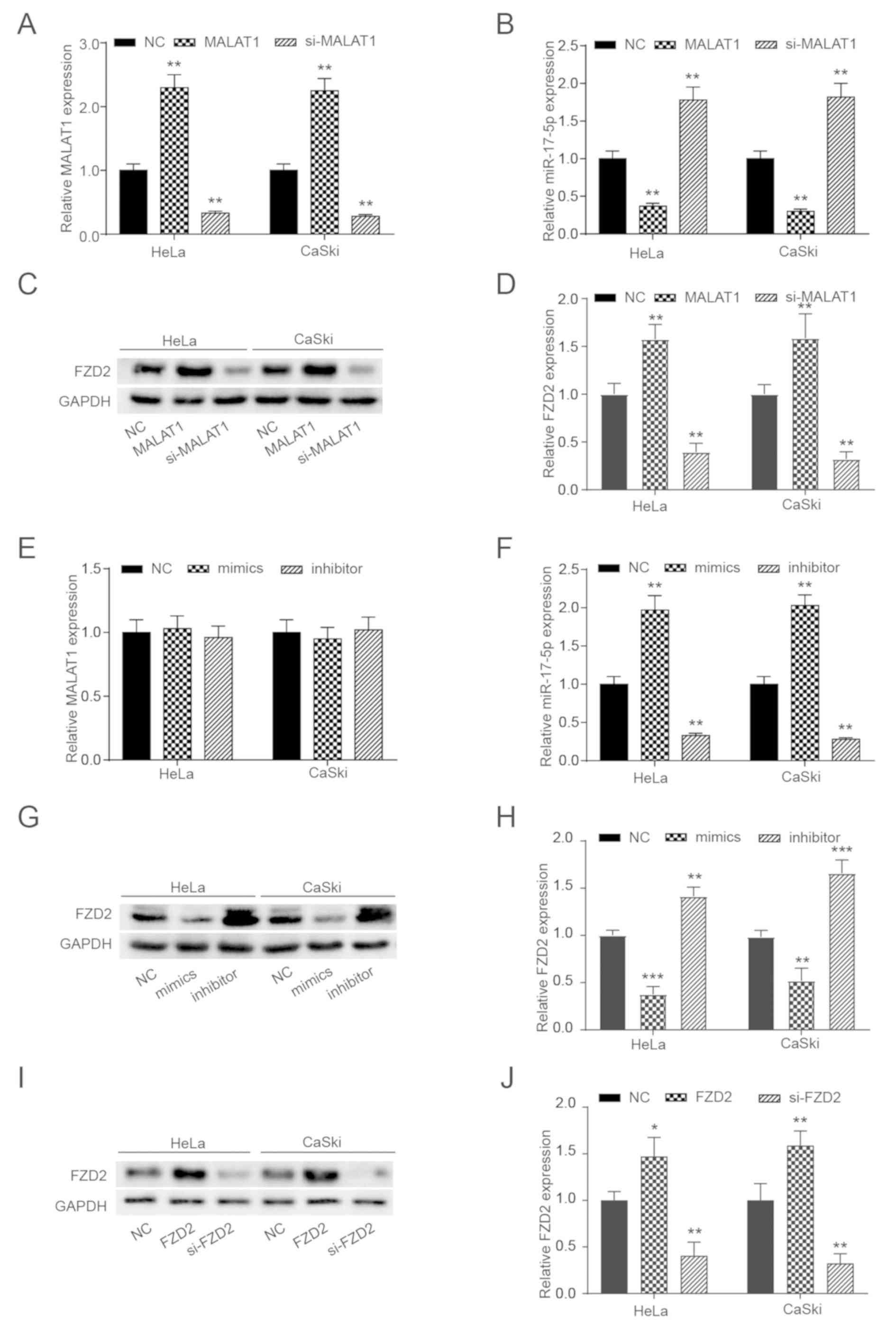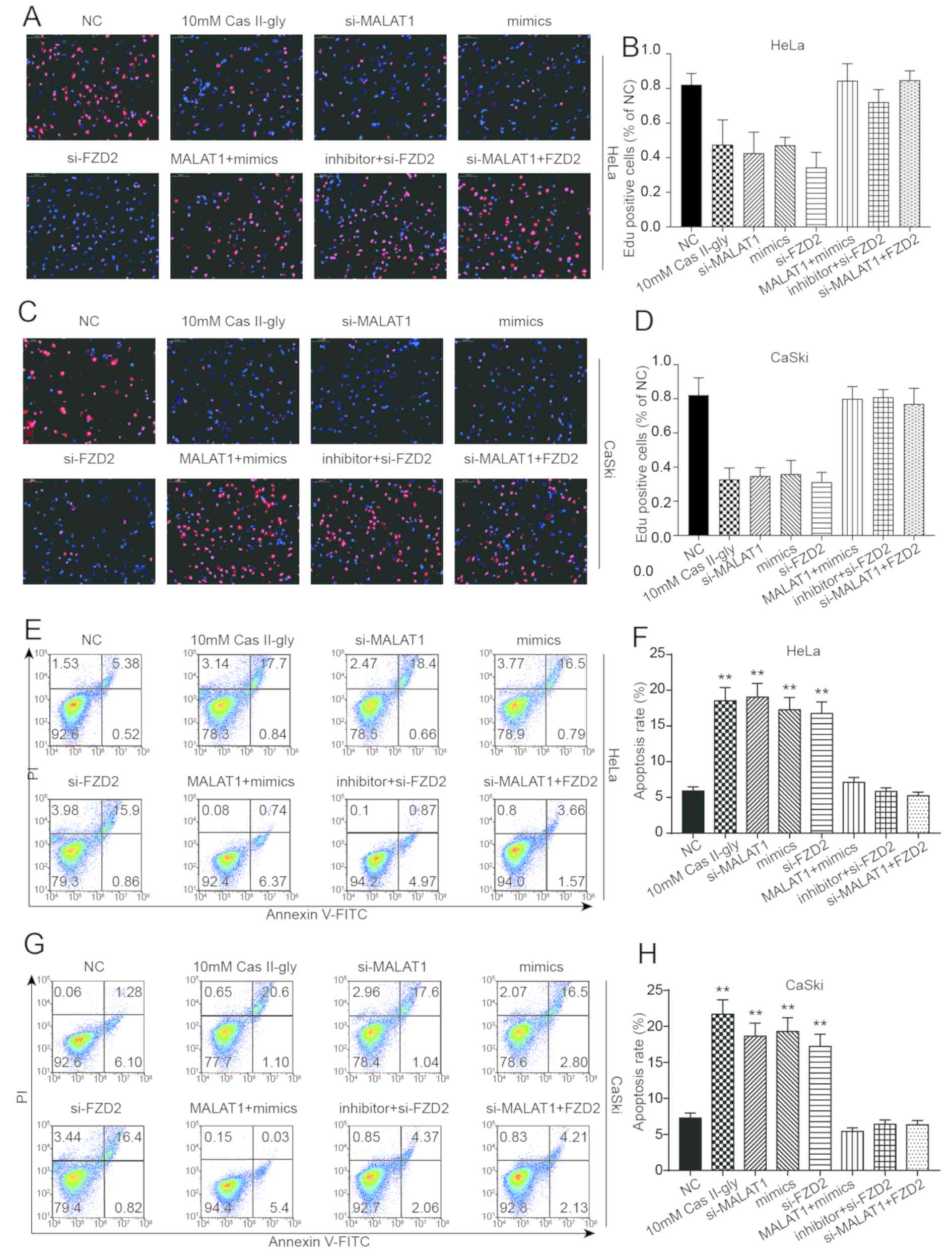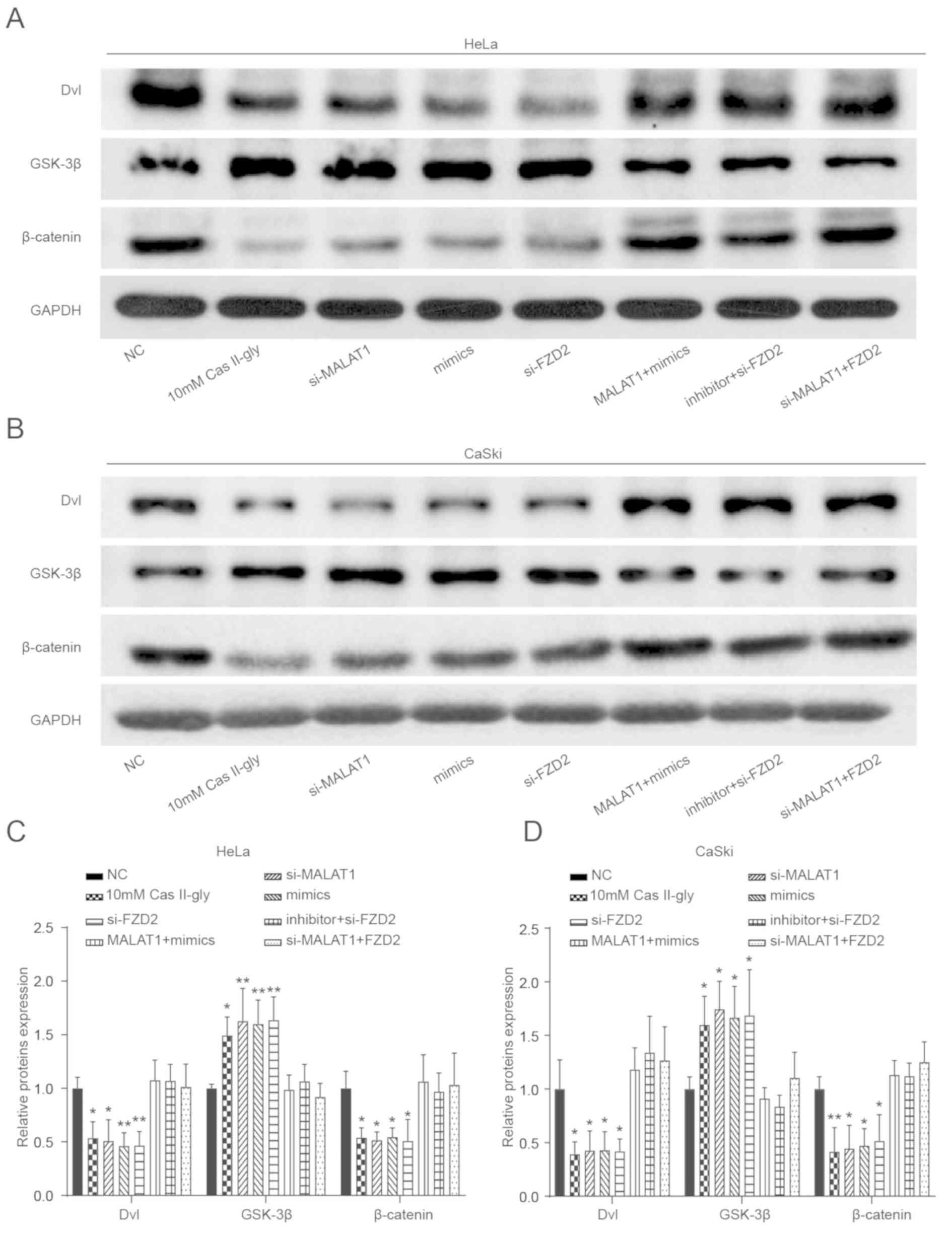|
1
|
Siegel RL, Miller KD and Jemal A: Cancer
statistics, 2018. CA Cancer J Clin. 68:7–30. 2018. View Article : Google Scholar : PubMed/NCBI
|
|
2
|
Tewari KS and Monk BJ: New strategies in
advanced cervical cancer: From angiogenesis blockade to
immunotherapy. Clin Cancer Res. 20:5349–5358. 2014. View Article : Google Scholar : PubMed/NCBI
|
|
3
|
McLaughlin-Drubin ME and Münger K: The
human papillomavirus E7 oncoprotein. Virology. 384:335–344. 2009.
View Article : Google Scholar : PubMed/NCBI
|
|
4
|
Scheffner M, Werness BA, Huibregtse JM,
Levine AJ and Howley PM: The E6 oncoprotein encoded by human
papillomavirus types 16 and 18 promotes the degradation of p53.
Cell. 63:1129–1136. 1990. View Article : Google Scholar : PubMed/NCBI
|
|
5
|
Leal-Garcia M, Garcia-Ortuno L,
Ruiz-Azuara L, Gracia-Mora I, Luna-Delvillar J and Sumano H:
Assessment of acute respiratory and cardiovascular toxicity of
casiopeinas in anaesthetized dogs. Basic Clin Pharmacol Toxicol.
101:151–158. 2007. View Article : Google Scholar : PubMed/NCBI
|
|
6
|
Chikira M, Tomizawa Y, Fukita D, Sugizaki
T, Sugawara N, Yamazaki T, Sasano A, Shindo H, Palaniandavar M and
Antholine WE: DNA-fiber EPR study of the orientation of Cu(II)
complexes of 1,10-phenanthroline and its derivatives bound to DNA:
Mono(phenanthroline)-copper(II) and its ternary complexes with
amino acids. J Inorg Biochem. 89:163–173. 2002. View Article : Google Scholar : PubMed/NCBI
|
|
7
|
Valencia-Cruz AI, Uribe-Figueroa LI,
Galindo-Murillo R, Baca-López K, Gutiérrez AG, Vázquez-Aguirre A,
Ruiz-Azuara L, Hernández-Lemus E and Mejía C: Whole genome gene
expression analysis reveals casiopeina-induced apoptosis pathways.
PLoS One. 8:e546642013. View Article : Google Scholar : PubMed/NCBI
|
|
8
|
Alemón-Medina R, Muñoz-Sánchez JL,
Ruiz-Azuara L and Gracia-Mora I: Casiopeina IIgly induced
cytotoxicity to HeLa cells depletes the levels of reduced
glutathione and is prevented by dimethyl sulfoxide. Toxicol In
Vitro. 22:710–715. 2008. View Article : Google Scholar : PubMed/NCBI
|
|
9
|
Winegarden N: Microarrays in cancer:
Moving from hype to clinical reality. Lancet. 362:14282003.
View Article : Google Scholar : PubMed/NCBI
|
|
10
|
Brown H: The real value of microarray
technology. Lancet Oncol. 4:3262003. View Article : Google Scholar : PubMed/NCBI
|
|
11
|
Butte A: The use and analysis of
microarray data. Nat Rev Drug Discov. 1:951–960. 2002. View Article : Google Scholar : PubMed/NCBI
|
|
12
|
Jin X, Chen X, Hu Y, Ying F, Zou R, Lin F,
Shi Z, Zhu X, Yan X, Li S and Zhu H: LncRNA-TCONS_00026907 is
involved in the progression and prognosis of cervical cancer
through inhibiting miR-143-5p. Cancer Med. 6:1409–1423. 2017.
View Article : Google Scholar : PubMed/NCBI
|
|
13
|
Xia YF, Pei GH, Wang N, Che YC, Yu FS, Yin
FF, Liu HX, Luo B and Wang YK: miR-3156-3p is downregulated in
HPV-positive cervical cancer and performs as a tumor-suppressive
miRNA. Virol J. 14:202017. View Article : Google Scholar : PubMed/NCBI
|
|
14
|
Li X, Tian R, Gao H, Yang Y, Williams BRG,
Gantier MP, McMillan NAJ, Xu D, Hu Y and Gao Y: Identification of a
histone family gene signature for predicting the prognosis of
cervical cancer patients. Sci Rep. 7:164952017. View Article : Google Scholar : PubMed/NCBI
|
|
15
|
Liao XH, Xiang Y, Yu CX, Li JP, Li H, Nie
Q, Hu P, Zhou J and Zhang TC: STAT3 is required for
MiR-17-5p-mediated sensitization to chemotherapy-induced apoptosis
in breast cancer cells. Oncotarget. 8:15763–15774. 2017. View Article : Google Scholar : PubMed/NCBI
|
|
16
|
Liang B, Li Y and Wang T: A three miRNAs
signature predicts survival in cervical cancer using bioinformatics
analysis. Sci Rep. 7:56242017. View Article : Google Scholar : PubMed/NCBI
|
|
17
|
Liang X, Liu Y, Zeng L, Yu C, Hu Z, Zhou Q
and Yang Z: miR-101 inhibits the G1-to-S phase transition of
cervical cancer cells by targeting Fos. Int J Gynecol Cancer.
24:1165–1172. 2014. View Article : Google Scholar : PubMed/NCBI
|
|
18
|
Zhao Y, Huang J, Liu T, He S, Shang C, Guo
L, Du Q and Yao S: Overexpression of long non-coding RNA
RP11-396F22.1 correlates poor prognosis of patients with
early-stage cervical cancer. Am J Transl Res. 10:684–695.
2018.PubMed/NCBI
|
|
19
|
Fan Y, Nan Y, Huang J, Zhong H and Zhou W:
Up-regulation of inflammation-related LncRNA-IL7R predicts poor
clinical outcome in patients with cervical cancer. Biosci Rep.
38(pii): BSR201804832018. View Article : Google Scholar : PubMed/NCBI
|
|
20
|
Ma TT, Zhou LQ, Xia JH, Shen Y, Yan Y and
Zhu RH: LncRNA PCAT-1 regulates the proliferation, metastasis and
invasion of cervical cancer cells. Eur Rev Med Pharmacol Sci.
22:1907–1913. 2018.PubMed/NCBI
|
|
21
|
Gao D, Zhang Y, Zhu M, Liu S and Wang X:
miRNA expression profiles of HPV-infected patients with cervical
cancer in the uyghur population in China. PLoS One.
11:e01647012016. View Article : Google Scholar : PubMed/NCBI
|
|
22
|
Jiang L, Shi S, Shi Q, Zhang H, Xia Y and
Zhong T: MicroRNA-519d-3p inhibits proliferation and promotes
apoptosis by targeting HIF-2α in cervical cancer under hypoxic
conditions. Oncol Res. 26:1055–1062. 2018. View Article : Google Scholar : PubMed/NCBI
|
|
23
|
Cai N, Hu L, Xie Y, Gao JH, Zhai W, Wang
L, Jin QJ, Qin CY and Qiang R: MiR-17-5p promotes cervical cancer
cell proliferation and metastasis by targeting transforming growth
factor-β receptor 2. Eur Rev Med Pharmacol Sci. 22:1899–1906.
2018.PubMed/NCBI
|
|
24
|
Rui X, Xu Y, Jiang X, Ye W, Huang Y and
Jiang J: Long non-coding RNA C5orf66-AS1 promotes cell
proliferation in cervical cancer by targeting miR-637/RING1 axis.
Cell Death Dis. 9:11752018. View Article : Google Scholar : PubMed/NCBI
|
|
25
|
Liang H, Zhang C, Guan H, Liu J and Cui Y:
LncRNA DANCR promotes cervical cancer progression by upregulating
ROCK1 via sponging miR-335-5p. J Cell Physiol. 234:7266–7278. 2019.
View Article : Google Scholar : PubMed/NCBI
|
|
26
|
Chen X, Xiong D, Yang H, Ye L, Mei S, Wu
J, Chen S, Shang X, Wang K and Huang L: Long noncoding RNA
OPA-interacting protein 5 antisense transcript 1 upregulated SMAD3
expression to contribute to metastasis of cervical cancer by
sponging miR-143-3p. J Cell Physiol. 234:5264–5275. 2019.
View Article : Google Scholar : PubMed/NCBI
|
|
27
|
Zheng P, Yin Z, Wu Y, Xu Y, Luo Y and
Zhang TC: LncRNA HOTAIR promotes cell migration and invasion by
regulating MKL1 via inhibition miR206 expression in HeLa cells.
Cell Commun Signal. 16:52018. View Article : Google Scholar : PubMed/NCBI
|
|
28
|
Feng Y, Zou W, Hu C, Li G, Zhou S, He Y,
Ma F, Deng C and Sun L: Modulation of CASC2/miR-21/PTEN pathway
sensitizes cervical cancer to cisplatin. Arch Biochem Biophys.
623-624:20–30. 2017. View Article : Google Scholar : PubMed/NCBI
|
|
29
|
Yang M, Wang M, Li X, Xie Y, Xia X, Tian
J, Zhang K and Tang A: Wnt signaling in cervical cancer? J Cancer.
9:1277–1286. 2018. View Article : Google Scholar : PubMed/NCBI
|
|
30
|
Gupta S, Kumar P and Das BC: HPV:
Molecular pathways and targets. Curr Probl Cancer. 42:161–174.
2018. View Article : Google Scholar : PubMed/NCBI
|
|
31
|
Li P, Hu J, Zhang Y, Li J, Dang Y, Zhang
R, Wei L and Shi M: miR-182 promotes cell proliferation of cervical
cancer cells by targeting adenomatous polyposis coli (APC) gene. Xi
Bao Yu Fen Zi Mian Yi Xue Za Zhi. 34:148–153. 2018.(In Chinese).
PubMed/NCBI
|
|
32
|
Smyth GK: Linear models and empirical
bayes methods for assessing differential expression in microarray
experiments. Stat Appl Genet Mol Biol. 3:Article32004. View Article : Google Scholar : PubMed/NCBI
|
|
33
|
Hollander SL: An unusual case of chronic
lymphocytic leukemia. J Med. 22:289–297. 1991.PubMed/NCBI
|
|
34
|
Yu G, Wang LG, Han Y and He QY:
ClusterProfiler: An R package for comparing biological themes among
gene clusters. OMICS. 16:284–287. 2012. View Article : Google Scholar : PubMed/NCBI
|
|
35
|
Kanehisa M, Goto S, Sato Y, Furumichi M
and Tanabe M: KEGG for integration and interpretation of
large-scale molecular data sets. Nucleic Acids Res. 40:D109–D114.
2012. View Article : Google Scholar : PubMed/NCBI
|
|
36
|
Prieto C, Risueno A, Fontanillo C and De
las Rivas J: Human gene coexpression landscape: Confident network
derived from tissue transcriptomic profiles. PLoS One. 3:e39112008.
View Article : Google Scholar : PubMed/NCBI
|
|
37
|
Bravo-Gómez ME, Garcia-Ramos JC,
Gracia-Mora I and Ruiz-Azuara L: Antiproliferative activity and
QSAR study of copper(II) mixed chelate
[Cu(N-N)(acetylacetonato)]NO3 and [Cu(N-N)(glycinato)]NO3
complexes, (Casiopeinas). J Inorg Biochem. 103:299–309. 2009.
View Article : Google Scholar : PubMed/NCBI
|
|
38
|
Alemon-Medina R, Bravo-Gomez ME,
Gracia-Mora MI and Ruiz-Azuara L: Comparison between the
antiproliferative effect and intracellular glutathione depletion
induced by Casiopeina IIgly and cisplatin in murine melanoma B16
cells. Toxicol In Vitro. 25:868–873. 2011. View Article : Google Scholar : PubMed/NCBI
|
|
39
|
Richter K, Haslbeck M and Buchner J: The
heat shock response: Life on the verge of death. Mol Cell.
40:253–266. 2010. View Article : Google Scholar : PubMed/NCBI
|
|
40
|
Isserlin R, Merico D, Voisin V and Bader
GD: Enrichment Map-a Cytoscape app to visualize and explore OMICs
pathway enrichment results. F1000Res. 3:1412014. View Article : Google Scholar : PubMed/NCBI
|
|
41
|
Marin-Hernandez A, Gracia-Mora I,
Ruiz-Ramirez L and Moreno-Sanchez R: Toxic effects of copper-based
antineoplastic drugs (Casiopeinas) on mitochondrial functions.
Biochem Pharmacol. 65:1979–1989. 2003. View Article : Google Scholar : PubMed/NCBI
|
|
42
|
Correia I, Borovic S, Cavaco I, Matos CP,
Roy S, Santos HM, Fernandes L, Capelo JL, Ruiz-Azuara L and Pessoa
JC: Evaluation of the binding of four anti-tumor
Casiopeínas® to human serum albumin. J Inorg Biochem.
175:284–297. 2017. View Article : Google Scholar : PubMed/NCBI
|
|
43
|
Zhang W and Liu HT: MAPK signal pathways
in the regulation of cell proliferation in mammalian cells. Cell
Res. 12:9–18. 2002. View Article : Google Scholar : PubMed/NCBI
|
|
44
|
Trejo-Solis C, Palencia G, Zuniga S,
Rodríguez-Ropon A, Osorio-Rico L, Luvia ST, Gracia-Mora I,
Marquez-Rosado L, Sánchez A, Moreno-García ME, et al: Cas IIgly
induces apoptosis in glioma C6 cells in vitro and in vivo through
caspase-dependent and caspase-independent mechanisms. Neoplasia.
7:563–574. 2005. View Article : Google Scholar : PubMed/NCBI
|
|
45
|
De Vizcaya-Ruiz A, Rivero-Muller A,
Ruiz-Ramirez L, Kass GE, Kelland LR, Orr RM and Dobrota M:
Induction of apoptosis by a novel copper-based anticancer compound,
casiopeina II, in L1210 murine leukaemia and CH1 human ovarian
carcinoma cells. Toxicol In Vitro. 14:1–5. 2000. View Article : Google Scholar : PubMed/NCBI
|
|
46
|
Rivero-Muller A, De Vizcaya-Ruiz A, Plant
N, Ruiz L and Dobrota M: Mixed chelate copper complex, Casiopeina
IIgly, binds and degrades nucleic acids: A mechanism of
cytotoxicity. Chem Biol Interact. 165:189–199. 2007. View Article : Google Scholar : PubMed/NCBI
|
|
47
|
Xia C, Liang S, He Z, Zhu X, Chen R and
Chen J: Metformin, a first-line drug for type 2 diabetes mellitus,
disrupts the MALAT1/miR-142-3p sponge to decrease invasion and
migration in cervical cancer cells. Eur J Pharmacol. 830:59–67.
2018. View Article : Google Scholar : PubMed/NCBI
|
|
48
|
Ji Q, Zhang L, Liu X, Zhou L, Wang W, Han
Z, Sui H, Tang Y, Wang Y, Liu N, et al: Long non-coding RNA MALAT1
promotes tumour growth and metastasis in colorectal cancer through
binding to SFPQ and releasing oncogene PTBP2 from SFPQ/PTBP2
complex. Br J Cancer. 111:736–748. 2014. View Article : Google Scholar : PubMed/NCBI
|
|
49
|
Dong Y, Liang G, Yuan B, Yang C, Gao R and
Zhou X: MALAT1 promotes the proliferation and metastasis of
osteosarcoma cells by activating the PI3K/Akt pathway. Tumour Biol.
36:1477–1486. 2015. View Article : Google Scholar : PubMed/NCBI
|
|
50
|
Xiao H, Tang K, Liu P, Chen K, Hu J, Zeng
J, Xiao W, Yu G, Yao W, Zhou H, et al: LncRNA MALAT1 functions as a
competing endogenous RNA to regulate ZEB2 expression by sponging
miR-200s in clear cell kidney carcinoma. Oncotarget. 6:38005–38015.
2015. View Article : Google Scholar : PubMed/NCBI
|
|
51
|
Zhang HM, Yang FQ, Chen SJ, Che J and
Zheng JH: Upregulation of long non-coding RNA MALAT1 correlates
with tumor progression and poor prognosis in clear cell renal cell
carcinoma. Tumour Biol. 36:2947–2955. 2015. View Article : Google Scholar : PubMed/NCBI
|
|
52
|
Li C, Chen H, Hu L, Xing Y, Sasaki T,
Villosis MF, Li J, Nishita M, Minami Y and Minoo P: Ror2 modulates
the canonical Wnt signaling in lung epithelial cells through
cooperation with Fzd2. BMC Mol Biol. 9:112008. View Article : Google Scholar : PubMed/NCBI
|
|
53
|
Bian Y, Chang X, Liao Y, Wang J, Li Y,
Wang K and Wan X: Promotion of epithelial-mesenchymal transition by
Frizzled2 is involved in the metastasis of endometrial cancer.
Oncol Rep. 36:803–810. 2016. View Article : Google Scholar : PubMed/NCBI
|
|
54
|
Zhang E, Li Z, Xu Z, Duan W, Sun C and Lu
L: Frizzled2 mediates the migration and invasion of human oral
squamous cell carcinoma cells through the regulation of the signal
transducer and activator of transcription-3 signaling pathway.
Oncol Rep. 34:3061–3067. 2015. View Article : Google Scholar : PubMed/NCBI
|
|
55
|
Ding LC, Huang XY, Zheng FF, Xie J, She L,
Feng Y, Su BH, Zheng DL and Lu YG: FZD2 inhibits the cell growth
and migration of salivary adenoid cystic carcinomas. Oncol Rep.
35:1006–1012. 2016. View Article : Google Scholar : PubMed/NCBI
|
|
56
|
Garzon R and Croce CM: MicroRNAs in normal
and malignant hematopoiesis. Curr Opin Hematol. 15:352–358. 2008.
View Article : Google Scholar : PubMed/NCBI
|
|
57
|
Wei Q, Li YX, Liu M, Li X and Tang H:
MiR-17-5p targets TP53INP1 and regulates cell proliferation and
apoptosis of cervical cancer cells. IUBMB Life. 64:697–704. 2012.
View Article : Google Scholar : PubMed/NCBI
|
|
58
|
Hu J, Wang Z, Shan Y, Pan Y, Ma J and Jia
L: Long non-coding RNA HOTAIR promotes osteoarthritis progression
via miR-17-5p/FUT2/β-catenin axis. Cell Death Dis. 9:7112018.
View Article : Google Scholar : PubMed/NCBI
|
|
59
|
He Z, Liao Z, Chen S, Li B, Yu Z, Luo G,
Yang L, Zeng C and Li Y: Downregulated miR-17, miR-29c, miR-92a and
miR-214 may be related to BCL11B overexpression in T cell acute
lymphoblastic leukemia. Asia Pac J Clin Oncol. 14:e259–e265. 2018.
View Article : Google Scholar : PubMed/NCBI
|
|
60
|
Li Z, Lu J, Sun M, Mi S, Zhang H, Luo RT,
Chen P, Wang Y, Yan M, Qian Z, et al: Distinct microRNA expression
profiles in acute myeloid leukemia with common translocations. Proc
Natl Acad Sci USA. 105:15535–15540. 2008. View Article : Google Scholar : PubMed/NCBI
|
|
61
|
Liu S, Song L, Zeng S and Zhang L:
MALAT1-miR-124-RBG2 axis is involved in growth and invasion of
HR-HPV-positive cervical cancer cells. Tumour Biol. 37:633–640.
2016. View Article : Google Scholar : PubMed/NCBI
|
|
62
|
Chen W, Zhao W, Zhang L, Wang L, Wang J,
Wan Z, Hong Y and Yu L: MALAT1-miR-101-SOX9 feedback loop modulates
the chemo-resistance of lung cancer cell to DDP via Wnt signaling
pathway. Oncotarget. 8:94317–94329. 2017.PubMed/NCBI
|
|
63
|
Chen W, Xu XK, Li JL, Kong KK, Li H, Chen
C, He J, Wang F, Li P, Ge XS and Li FC: MALAT1 is a prognostic
factor in glioblastoma multiforme and induces chemoresistance to
temozolomide through suppressing miR-203 and promoting thymidylate
synthase expression. Oncotarget. 8:22783–22799. 2017.PubMed/NCBI
|
|
64
|
Pećina-Slaus N: Wnt signal transduction
pathway and apoptosis: A review. Cancer Cell Int. 10:222010.
View Article : Google Scholar : PubMed/NCBI
|
|
65
|
Chen S, Guttridge DC, You Z, Zhang Z,
Fribley A, Mayo MW, Kitajewski J and Wang CY: Wnt-1 signaling
inhibits apoptosis by activating beta-catenin/T cell
factor-mediated transcription. J Cell Biol. 152:87–96. 2001.
View Article : Google Scholar : PubMed/NCBI
|
|
66
|
You L, He B, Uematsu K, Xu Z, Mazieres J,
Lee A, McCormick F and Jablons DM: Inhibition of Wnt-1 signaling
induces apoptosis in beta-catenin-deficient mesothelioma cells.
Cancer Res. 64:3474–3478. 2004. View Article : Google Scholar : PubMed/NCBI
|
|
67
|
Li F, Chong ZZ and Maiese K: Winding
through the WNT pathway during cellular development and demise.
Histol Histopathol. 21:103–124. 2006.PubMed/NCBI
|
|
68
|
Uematsu K, He B, You L, Xu Z, McCormick F
and Jablons DM: Activation of the Wnt pathway in non small cell
lung cancer: Evidence of dishevelled overexpression. Oncogene.
22:7218–7221. 2003. View Article : Google Scholar : PubMed/NCBI
|















